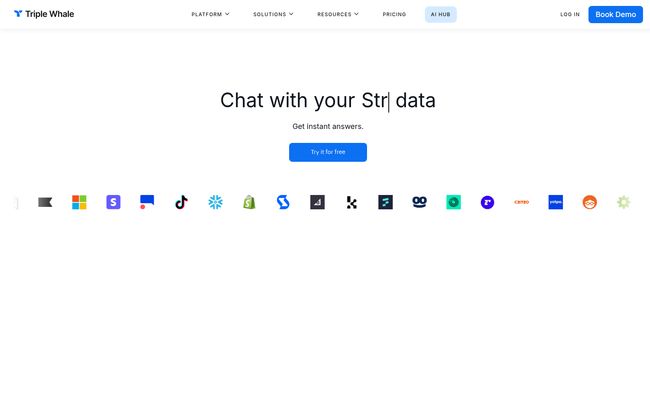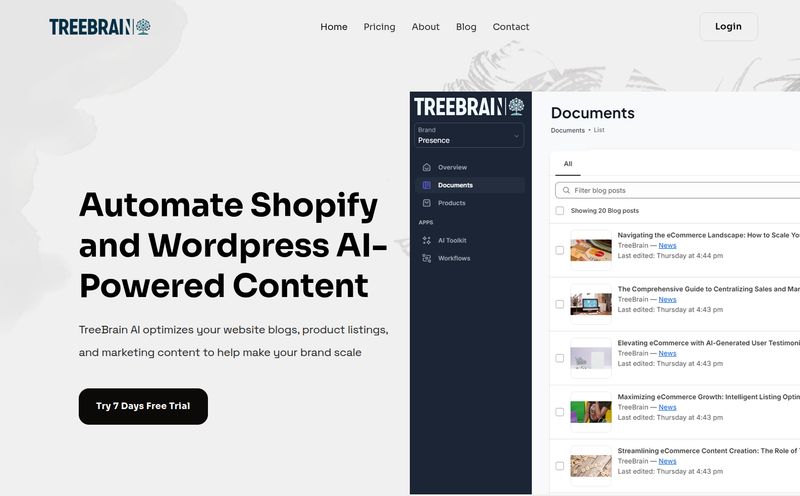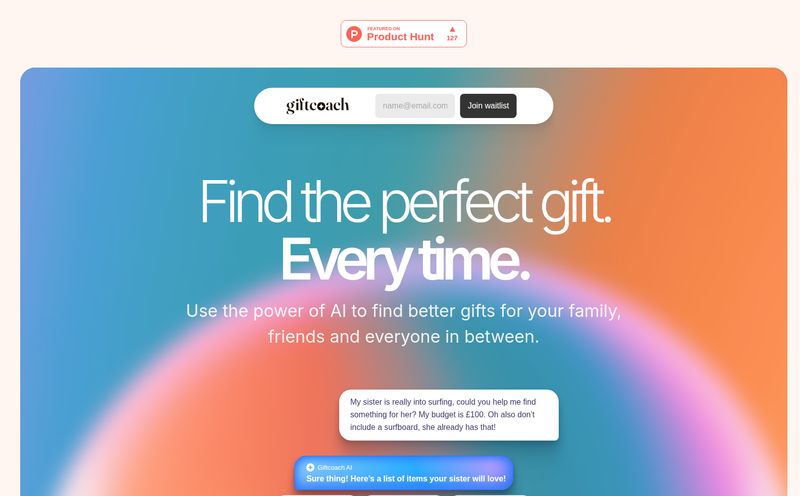Alright, let’s have a real chat. If you’re running an e-commerce brand, you know the feeling. You’re drowning in data. You’ve got a tab open for Google Analytics, another for your Facebook Ads manager, one for your email platform, maybe another for TikTok, and your Shopify dashboard is practically burned into your screen. It’s a mess. You’re trying to connect the dots, figure out what’s actually working, and it feels like you're trying to solve a puzzle in the dark. We've all been there.
For years, the solution was to either hire a data scientist (good luck with that budget) or stitch together a Frankenstein’s monster of different reporting tools. And then, a few years back, this blue whale started swimming into the feeds of every DTC marketer. Triple Whale. It promised a single source of truth. Better data. Faster insights. And now, they're talking about AI agents.
So, is it just another fancy dashboard with a high price tag, or is it genuinely the co-pilot that can help you navigate the stormy seas of e-commerce? As someone who’s spent more years than I’d like to admit obsessing over CPCs and ROAS, I’ve been watching them closely. Here’s my no-fluff, honest-to-goodness take.
What Even Is Triple Whale?
Let's get one thing straight: calling Triple Whale just a 'dashboard' is like calling a Tesla just a 'car'. It misses the point. At its core, Triple Whale is an agent-powered intelligence platform. Think of it less like a rearview mirror showing you what already happened, and more like a GPS with a really, really smart navigator telling you the best way to go.
The whole idea is to unify all your data—from your store, your ad platforms, your email marketing—into one central hub. One single source of truth. No more arguing with your agency about whether a sale came from Facebook or Google. The data is just... there. It’s designed to turn the overwhelming complexity of data into simple, profitable actions. A pretty lofty goal, if you ask me.

Visit Triple Whale
Meet Moby, Your New AI Data Analyst
This is where things get interesting and, frankly, a bit futuristic. Triple Whale's big new thing is Moby, their AI brain. When they say 'agent-powered', they're talking about this. Moby isn't just a chatbot you ask questions to (though it can do that). It's a collection of AI agents that proactively monitor your business.
For instance, they have a Creative Analysis agent that sifts through your ad creatives to tell you what's working and what's tanking, automatically. Or a Customer Retention agent that identifies patterns in repeat purchases. It’s like having a junior data analyst on your team who never sleeps, never complains, and is obsessed with finding you opportunities to make more money. It’s a powerful concept, and from what I've seen, it's a huge step up from just looking at static charts and trying to figure out the 'why' by yourself.
The Core Features That Actually Matter
An AI is only as good as the data it has to work with. Triple Whale is built on a few powerful pillars that make the whole thing tick.
The Triple Whale Pixel and Attribution
Ever since the infamous iOS 14 update, attribution has been the bane of every marketer's existence. Facebook says it got 50 sales, Google says it got 40, and Shopify says you only got 60 total. Who do you believe? Triple Whale's answer is its own server-side pixel combined with best-in-class multi-touch attribution (MTA) models. It gives you a much clearer, more believable picture of a customer's entire path to purchase, from that first TikTok view to the final click on a Google Shopping ad. It’s not perfect—nothing is—but its a hell of a lot better than flying blind.
Marketing Mix Modeling (MMM) Without the Headache
Okay, stay with me here. Marketing Mix Modeling (MMM) is a fancy way of saying you're looking at your marketing from a 30,000-foot view to see how different channels influence each other and drive overall sales. Big-shot brands pay agencies hundreds of thousands of dollars for this stuff. Triple Whale has built it right into their platform. This helps you answer the big questions, like "If I increase my budget on YouTube by 20%, what will happen to my total revenue?" It’s a strategic tool that, until recently, was out of reach for most ecom brands.
Dashboards and BI That Don't Require a PhD
While the AI is the sexy part, the day-to-day value comes from their dashboards. They are clean, customizable, and fast. You can build your own reports or use their pre-built templates. The beauty is in the speed to insight. Instead of spending half your Monday pulling reports, you can have a live, real-time view of your business performance in one place. It makes you feel more in control, which any founder will tell you is priceless.
So, How Much Does This Cost? A Look at Triple Whale Pricing
This is the million-dollar question, isn't it? Or at least the several-hundred-dollar-a-month question. Pricing can be a bit of a moving target because it's tied to your store's Gross Merchandise Volume (GMV), but here's the general breakdown based on their public pricing for stores with over $250k in annual GMV.
| Plan | Price (Starting From) | Who It's For |
|---|---|---|
| Free | $0 / month | Brands just starting out, wanting to track basic real-time metrics in one place. |
| Starter | $149 / month | Growing brands that need solid attribution and all their marketing channels in one view. |
| Advanced | $219 / month | Scaling brands ready for deeper insights like cohort analysis, creative analytics, and BI tools. |
| Professional | $449 / month | Larger businesses looking to leverage advanced tools like MMM for strategic budget allocation. |
Important Note: These prices can and will change based on your GMV. The higher your revenue, the more the platform will cost. It's a value-based model, which makes sense, but be sure to get a custom quote.
The Good, The Bad, and The Realistic
No tool is perfect. Let's weigh the pros and cons like seasoned professionals.
What I Genuinely Like
The biggest win for me is the unified platform. The sheer mental energy saved by not having to jump between ten different tools is massive. The AI agents are genuinely impressive and feel like the future of how we'll interact with our business data. And having access to real-time data across everything gives you a sense of command that's hard to put a price on.
A Few Things to Keep in Mind
On the flip side, some will argue that the price is steep, especially as your GMV grows. And they're not wrong—it’s an investment. It’s also not plug-and-play. You have to integrate it with your tech stack, and there's a definite learning curve. You're not going to be an expert in an afternoon, and that's okay. Powerful tools require a little effort to master. Think of it like getting a professional camera; you need to learn the settings to get the best shots.
Who is Triple Whale Really For?
So, who should pull the trigger? In my experience, Triple Whale is a fantastic fit for established DTC brands that are actively spending on multiple ad channels and feel the pain of data chaos. If you're a founder or marketer who lies awake at night wondering where your sales are really coming from, this is for you.
If you're just starting out or only running ads on one channel, the Free or Starter plans might be enough. But the real magic, the AI and the advanced modeling, is for the brands ready to scale seriously. It’s probably overkill for a small side-hustle or a B2B service business.
Frequently Asked Questions (FAQ)
How is Triple Whale different from Google Analytics 4?
GA4 is a powerful web analytics tool, but it's just one piece of the puzzle. Triple Whale integrates data from GA4 alongside your ad platforms (Meta, Google, TikTok), your store (Shopify), and your email platform to give you a complete business overview, not just a website overview. Plus, its attribution modeling is often considered more accurate for e-commerce.
Is Moby AI just another chatbot?
No. While you can chat with it, its main function is to be a set of proactive agents that constantly analyze your data for you. It finds insights and brings them to your attention, rather than waiting for you to ask the right question.
Do I need to be a data expert to use it?
Not at all. In fact, it's designed for founders and marketers who aren't data scientists. It does the heavy lifting to present insights in a way that's easy to understand and act on. That said, a basic understanding of marketing metrics is definitely helpful.
How long does the setup take?
The basic setup is surprisingly quick. You can connect your Shopify store and ad accounts in under an hour. Fine-tuning everything and learning the ropes will take a bit longer, but you can start getting value on day one.
Can it really solve my iOS 14 attribution issues?
It can significantly help. By using a combination of its own pixel, server-side tracking, and advanced modeling, it fills in many of the gaps left by Apple's privacy changes. It provides a more stable and holistic view of performance than relying on in-platform reporting alone.
Is the pricing really based on my store's revenue?
Yes, the pricing tiers scale with your Gross Merchandise Volume (GMV). This ensures the value you get from the platform is aligned with the cost. Always check their pricing page or talk to their sales team for a quote specific to your business.
The Final Verdict
In a digital world that gets more complex by the day, clarity is the ultimate competitive advantage. Triple Whale isn't a magic wand that will instantly fix a broken business model. But it is an incredibly powerful ally. It's a translator for the complex language of data, a co-pilot for navigating your growth strategy, and a glimpse into a future where AI helps us make smarter, faster, and more profitable decisions.
If you’re serious about scaling your e-commerce brand on data-driven decisions, Triple Whale is, in my professional opinion, an investment worth investigating.



